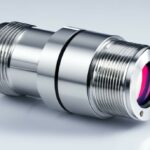Last Updated on 4 months by Francis
Motion sensors are an essential component of a security system, capable of detecting movement and alerting homeowners or monitoring centers to potential threats. When it comes to motion sensors, one type that stands out is infrared motion sensors, also known as passive infrared sensors (PIR). These sensors detect body heat, or infrared energy, and are widely used in home security systems.
Infrared motion sensors are highly effective in detecting movement, making them the preferred choice for both residential and commercial settings. They work by measuring temperature changes in the surrounding environment, allowing them to differentiate between normal changes and the presence of an intruder. Infrared motion sensors have become the norm in motion sensor technology due to their reliability and cost-effectiveness.
Contents
Key Takeaways
- Infrared motion sensors, also known as PIR sensors, are widely used in home security systems.
- These sensors detect body heat, or infrared energy, making them highly effective in detecting movement.
- Infrared motion sensors are the norm in motion sensor technology due to their reliability and cost-effectiveness.
- They work by measuring changes in temperature and can differentiate between normal changes and the presence of an intruder.
- They are commonly used in both residential and commercial settings.
Role of Motion Sensors in Security Systems

The role of motion sensors in security systems is critical to ensuring the safety and protection of both residential and commercial spaces. These advanced sensors play a vital role in detecting the presence of intruders and initiating timely alerts, enabling homeowners or monitoring centers to take immediate action.
When a motion sensor detects movement within its range, it sends a signal to the security system’s control panel, which then triggers the appropriate response, such as sounding an alarm or notifying authorities. This swift detection capability allows for rapid responses to potential threats and helps prevent unauthorized access.
Motion sensors are strategically placed in key areas of a property, such as living rooms, windows, and doors, to effectively monitor entry points and detect any unauthorized movement. This ensures comprehensive coverage and enhances the overall security level of the premises.
However, the applications of motion sensors extend beyond intruder detection. These versatile sensors have various other important roles in security systems, including:
- Alerting parents if a child breaks curfew: Motion sensors can be utilized to monitor restricted areas within the property, such as a teenager’s bedroom or the liquor cabinet. If the sensor detects movement during specific hours, it can send a notification to the parent’s smartphone, allowing them to address the situation promptly.
- Triggering a doorbell when someone approaches the front door: Motion sensors integrated with doorbell systems can detect someone approaching the front door and automatically ring the doorbell, providing convenience and enhancing security.
- Saving energy by activating motion sensor lighting in unoccupied spaces: Motion sensors can be integrated with lighting systems to automatically turn on lights when occupancy is detected and turn them off when the area becomes unoccupied. This not only saves energy but also provides convenience and lower utility costs.
The diverse applications of motion sensors demonstrate their importance in enhancing security, convenience, and energy efficiency. Whether for residential or commercial use, motion sensor technology plays a vital role in safeguarding properties and ensuring peace of mind for homeowners and occupants.
Types of Motion Sensors

When it comes to motion sensors, there are several types available to suit different security needs. Let’s explore the most common types: infrared motion sensors, microwave motion sensors, and dual technology motion sensors.
Infrared Motion Sensors (PIR Sensors)
Infrared motion sensors, also known as PIR sensors, are the most widely used type of motion sensors. They detect movement by capturing infrared energy emitted by objects within their range. Specifically, PIR sensors are highly effective in detecting body heat, making them ideal for home security systems. These sensors are cost-effective, reliable, and widely available.
Microwave Motion Sensors
Microwave motion sensors work by emitting microwave pulses and measuring the reflections off of moving objects. These sensors cover a larger area compared to infrared motion sensors, making them suitable for wide spaces. However, microwave sensors are more expensive and can be susceptible to electrical interference.
Dual Technology Motion Sensors
Dual technology motion sensors combine the strengths of both infrared and microwave sensors to provide more accurate detection and reduce false alarms. By combining the two technologies, they can better differentiate between actual movement and environmental factors that might trigger false alarms. This makes dual technology sensors a popular choice for commercial applications where reliable detection is crucial.
Now that we have explored the different types of motion sensors, let’s move on to the advantages of infrared motion sensors and how they enhance security systems.
Did you know? Infrared motion sensors (PIR sensors) are the most widely used type of motion sensors in home security systems.
Advantages of Infrared Motion Sensors

Infrared motion sensors, also known as passive infrared sensors (PIR), offer a range of advantages that make them ideal for motion detection in various settings. Here are some key benefits of using infrared motion sensors:
- Highly Reliable and Accurate: Infrared motion sensors excel in detecting movement, especially body heat. They can differentiate between the infrared energy emitted by humans and other objects, minimizing false alarms triggered by moving branches or pets.
- Cost-Effective and Widely Available: Infrared motion sensors are affordable and readily accessible, making them a popular choice for homeowners and businesses alike. Their widespread availability ensures easy procurement and compatibility with different security systems.
- Easy Installation and Integration: Installing infrared motion sensors is a breeze. They can be seamlessly integrated into existing security systems, eliminating the need for complex modifications. Whether you opt for a professional installation or choose the DIY route, setting up these sensors is hassle-free.
With their advanced technology and numerous benefits, infrared motion sensors provide reliable and effective motion detection, enhancing the security of your premises.
Uses of Motion Sensors

Motion sensors have a wide range of applications beyond security systems. They are versatile devices that can be utilized in various ways to enhance convenience, energy efficiency, and safety in both residential and commercial settings.
1. Automation of Lighting Systems
Motion sensor lights have become increasingly popular in homes and workplaces due to their ability to automatically turn on when someone enters a room and turn off when the space is unoccupied. These lights not only provide convenience but also save energy by ensuring that lights are only turned on when needed. They are commonly used in hallways, garages, and outdoor spaces, making movement effortless and reducing the risk of accidents in the dark.
2. Activation of Doorbells
Integrated with doorbell systems, motion sensors can activate doorbells when someone approaches the front door. This feature provides an extra layer of security by notifying homeowners of visitors or deliveries, even when they are not near the entrance. The ability to connect motion sensors with doorbells also adds convenience, as it eliminates the need to manually press a doorbell button.
3. Alarming Restricted Areas
Motion sensors can be used to alert parents of their child’s movement in restricted areas, such as medicine cabinets, liquor cabinets, or storage rooms. By placing motion sensors in these areas, parents can be instantly notified if their child attempts to access them, ensuring safety and preventing accidents or unauthorized access.
4. Integration with Smart Home Systems
Motion sensors play a significant role in smart home systems, enabling automation and control of various devices based on movement. For example, a motion sensor can be used to activate the thermostat and adjust the temperature as someone enters a room, providing comfort and energy efficiency. They can also be programmed to turn on music, adjust lighting, or open curtains, creating personalized and convenient experiences.
5. Integration with Security Cameras
Combining motion sensors with security cameras enhances the effectiveness and efficiency of video surveillance systems. When motion is detected, the motion sensors trigger the security cameras to start recording, ensuring that important events are captured and eliminating the need to sift through hours of useless footage. This integration conserves storage space and allows for easy retrieval of significant footage.
Overall, motion sensors have diverse applications that go beyond traditional security systems. From automating lighting systems and activating doorbells to alerting parents of movement in restricted areas and integrating with smart home systems, motion sensors provide convenience, energy efficiency, and enhanced safety.
Working Principle of Infrared Motion Sensors

Infrared motion sensors, also known as PIR sensors, operate by detecting changes in temperature. These sensors consist of two pyroelectric sensors that detect infrared radiation and measure the difference in infrared levels between the two sensors. When a moving object enters the sensor’s range, it causes a change in the levels of infrared energy, triggering an alarm or alert.
The working principle of PIR sensors can be summarized as follows: they detect the heat emitted by living beings and objects and use this information to detect movement. By focusing on the detection of infrared energy, PIR sensors can accurately differentiate human presence from other sources of infrared energy, such as pets or background heat.
To provide a visual representation of the working principle of infrared motion sensors, refer to the following table:
Working Principle of Infrared Motion Sensors
| Component | Function |
|---|---|
| Infrared Radiation | Emitted by living beings and objects |
| Pyroelectric Sensors | Detect infrared radiation |
| Difference in Infrared Levels | Measured between the two sensors |
| Moving Object | Causes change in infrared energy levels |
| Alarm or Alert | Triggered by the changes detected |
“Infrared motion sensors, or PIR sensors, detect the heat emitted by living beings and objects, using this information to detect movement and accurately differentiate it from other sources of infrared energy.”
Where to Place Motion Sensors
Proper placement of motion sensors is crucial for optimal coverage and accurate detection. By strategically positioning your motion sensors, you can maximize their effectiveness in detecting intruders while minimizing false alarms caused by other factors.
Key Tips for Motion Sensor Placement:
- Identify choke-points: Place motion sensors in areas where intruders are likely to pass through, such as stairwells and main hallways. These high-traffic areas ensure thorough detection and enhance the security of your home.
- Secure entry points: Install motion sensors near doors, windows, and garage doors to detect unauthorized entry attempts. These key access points are prime locations for placing sensors.
- Avoid heat sources: Position your motion sensors away from heat sources like radiators, heating vents, or sunny windows. Rapid changes in heat can trigger false alarms, compromising the reliability of your system.
It’s essential to carefully read the installation instructions provided by the manufacturer for each specific motion sensor model. They often include recommended placement guidelines based on the sensor’s specifications. Following these guidelines ensures optimal coverage and performance.
Remember, the goal is to create a security system that effectively detects intruders while minimizing the chances of false alarms. Thoughtful placement of motion sensors is key to achieving this balance.
Pro Installation vs. DIY Installation
When it comes to installing motion sensors, homeowners have the option of professional installation or DIY installation.
Professional installation, offered by companies like Vivint home security, ensures that motion sensors are correctly placed and can handle specific needs, such as active pets. Professionals have experience in identifying the optimal spots for motion sensors and ensuring they are securely installed.
“Professional installation provides peace of mind, knowing that experts have installed your motion sensors properly and have considered all potential factors that could affect their performance.”
On the other hand, DIY installation is more cost-effective and accessible for those who prefer to handle the installation themselves. Many motion sensor systems are designed for easy installation, and detailed instructions are provided to guide homeowners through the process. DIY installation allows homeowners to have control over the placement of the motion sensors and tailor the system to their specific needs. It can also be a rewarding experience for those who enjoy DIY projects.
“DIY installation offers flexibility and the satisfaction of completing the installation on your own. It can save you money and give you a sense of accomplishment.”
The choice between professional installation and DIY installation ultimately depends on personal preferences and the complexity of the system. If you are unsure about the technical aspects of installation or want the assurance of a professional’s expertise, professional installation may be the best choice for you. However, if you are comfortable with following instructions and enjoy hands-on projects, DIY installation can be a rewarding option. Consider your skills, available time, and desired level of involvement when making this decision.
| Professional Installation | DIY Installation |
|---|---|
| Expertise and experience in proper placement | Control over sensor placement |
| Ability to handle specific needs (e.g., active pets) | Cost-effective option |
| Assurance of a professionally installed system | Sense of accomplishment |
| Flexibility to customize the system |
Ultimately, whether you choose professional installation or DIY installation, the important thing is to ensure that your motion sensors are properly installed and effectively enhance the security of your home.
Conclusion
Infrared motion sensors, also known as PIR sensors, are the go-to choice for motion detection in home security systems. These sensors are highly effective in detecting movement by utilizing infrared energy to detect body heat. With their cost-effectiveness, reliability, and ease of installation, infrared motion sensors have become the norm in motion sensor technology.
Aside from security systems, infrared motion sensors have a wide range of applications. They can be used to automate lighting systems, ensuring energy efficiency and convenience. Additionally, these sensors can serve as alarms in restricted areas, alerting homeowners to movement and enhancing overall security.
Proper placement of motion sensors is crucial for maximizing their effectiveness and minimizing false alarms. Placing sensors in strategic locations such as choke-points and entry points helps ensure thorough detection and coverage. Whether homeowners choose professional installation or decide to take on the installation themselves, infrared motion sensors offer enhanced security and convenience in both residential and commercial spaces.
FAQ
Are motion sensors infrared?
Yes, infrared motion sensors, also known as passive infrared sensors (PIR), are the most widely used type of motion sensor in home security systems.
How do infrared motion sensors work?
Infrared motion sensors work by measuring changes in temperature. They detect body heat (infrared energy) and are highly effective in detecting movement.
What are the types of motion sensors?
There are several types of motion sensors, including infrared motion sensors, microwave motion sensors, and dual technology motion sensors.
What are the advantages of infrared motion sensors?
Infrared motion sensors offer several advantages, including reliable and accurate motion detection, cost-effectiveness, and ease of installation.
What are the uses of motion sensors?
Motion sensors have diverse applications beyond security systems, such as automating lighting systems, activating doorbells, and alerting parents of a child’s movement in restricted areas.
How do infrared motion sensors detect motion?
Infrared motion sensors, or PIR sensors, detect motion by measuring changes in temperature. They differentiate the infrared energy emitted by humans from other sources of infrared energy.
Where should I place motion sensors?
Motion sensors should be strategically placed in areas such as living rooms, windows, and doors to detect any unauthorized entry or movement. They should also be positioned away from heat sources to prevent false alarms.
Should I opt for professional installation or DIY installation?
The choice between professional installation and DIY installation depends on personal preferences and the complexity of the system. Professional installation ensures correct placement, while DIY installation is more cost-effective.
In summary, what are infrared motion sensors?
Infrared motion sensors, or PIR sensors, are the norm in motion sensor technology. They detect body heat, provide reliable and accurate motion detection, and play a significant role in enhancing security and convenience.








